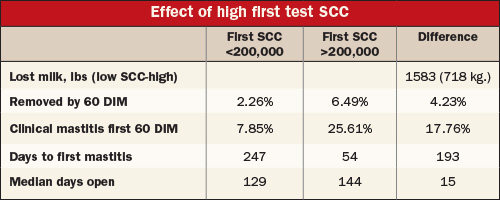By Amanda Smith, Hoard’s Dairyman Associate Editor After calving, a cow’s immune system has its defenses down, bacteria pounce, often leading to a mastitis infection.
While a clinical case is easily detected, its subclinical counterpart is a bit more elusive.
“Somatic cell counts greater than 200,000 cells/mL are indicative of a subclinical mastitis infection,” said Mark Kirkpatrick, Zoetis, at the National Mastitis Council annual meeting. Dairies that conduct monthly individual cow SCC testing through DHI can monitor early lactation udder health through first test day somatic cell counts.
Kirkpatrick examined lactation records for the presence of a high first test somatic cell count, or a recorded clinical mastitis case in the first 60 days in lactation. Records, representing 164,423 Holstein cows, were obtained from 22 Western herds.
A cow was declared subclinically infected if somatic cells were above 200,000 cells/mL at the first DHI test. Lactation curves were created for cows with or without a high first test SCC and for cows with or without a mastitis infection in the first 60 days in milk.
For cows with clinical mastitis, the calculated difference between curves represented a loss of 1,007 pounds of milk, or $181 in lost milk yield. Losses extended out to 270 days of lactation.


Subclinical and clinical mastitis both reduced conception risk. Cows with either condition required an additional 15 to 17 days to become pregnant.
“Even in the face of no quality bonuses, it is in the financial best interest of the producer to utilize resources, processes and labor to exert control of herd udder health,” concluded Kirkpatrick.
“Reprinted by permission from Hoard’s Dairyman Intel on February 9, 2015 found at http://www.hoards.com/intel/
Source: Hoards Dairyman




